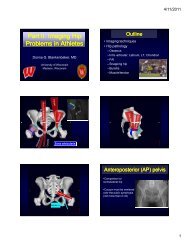Ankle and Foot 47 - Department of Radiology - University of ...
Ankle and Foot 47 - Department of Radiology - University of ...
Ankle and Foot 47 - Department of Radiology - University of ...
You also want an ePaper? Increase the reach of your titles
YUMPU automatically turns print PDFs into web optimized ePapers that Google loves.
<strong>47</strong> <strong>Ankle</strong> <strong>and</strong> <strong>Foot</strong> 2313 <strong>47</strong><br />
A B C<br />
D<br />
E<br />
Figure <strong>47</strong>-118. Giant cell tumor <strong>of</strong> the tendon sheath in a 19-year-old with a palpable medial mass. A, Straight axial T1-weighted image through<br />
the mass (arrow) demonstrates that it lies within the s<strong>of</strong>t tissues medial to the navicular (N), talus (Ta), <strong>and</strong> sustentaculum tali (ST) but does not<br />
invade the bones. B, The corresponding axial proton-density–weighted image shows that the mass has grown through a split tendon sheath<br />
(arrowheads). The tendons themselves—posterior tibial (T), flexor digitorum longus (D), <strong>and</strong> flexor hallucis longus (H)—are intact <strong>and</strong> normal<br />
in appearance with no evidence <strong>of</strong> tumor involvement. C, The corresponding axial T2-weighted image shows that the mass (arrow) has<br />
heterogeneous signal intensity, consistent with the presence <strong>of</strong> blood products <strong>of</strong> varying ages. D, Corresponding axial precontrast fat-suppressed<br />
T1-weighted image reveals that some signal in the mass is brighter than the surrounding suppressed fat, consistent with methemoglobin.<br />
E, Corresponding axial post–intravenous gadolinium fat-suppressed T1-weighted image demonstrates heterogeneous enhancement, indicative <strong>of</strong><br />
the vascularity <strong>of</strong> this synovial proliferation.<br />
Chondroblastomas are rare benign cartilaginous neoplasms,<br />
<strong>and</strong> one <strong>of</strong> the few tumors that arise from the<br />
epiphysis in a skeletally immature patient. Chondroblastomas<br />
can exp<strong>and</strong> the cortex but should not cross the unfused<br />
growth plate (Fig. <strong>47</strong>-120A). Radiographically, chondroblastomas<br />
can have either a lucent or chondroid matrix. By<br />
MRI, these lesions may exhibit considerable edema in the<br />
surrounding s<strong>of</strong>t tissues, but the tumor itself should have<br />
a sharp, non–aggressive-appearing interface with the<br />
normal bone (see Fig. <strong>47</strong>-120B to D).<br />
Intraosseous lipomas <strong>of</strong> the calcaneus are rare but have<br />
a characteristic radiographic appearance in that they are<br />
well circumscribed <strong>and</strong> nearly totally lucent except for a<br />
tiny central sclerotic focus (Fig. <strong>47</strong>-121A). By MRI, the<br />
intraosseous lipoma is uniformly isointense to fat on all<br />
sequences, except for a signal void corresponding to the<br />
sclerotic focus (Fig. <strong>47</strong>-121C <strong>and</strong> D).<br />
• Malignant Tumors<br />
The most common primary malignant tumor <strong>of</strong> the foot<br />
is chondrosarcoma, which has a propensity for the calcaneus<br />
(Fig. <strong>47</strong>-122). High-grade chondrosarcomas have a<br />
calcified matrix that appears radiographically sclerotic (see<br />
Fig. <strong>47</strong>-122A) <strong>and</strong> dark on T1- <strong>and</strong> T2-weighted sequences.<br />
Chondrosarcomas are not highly vascularized tumors <strong>and</strong><br />
Ch0<strong>47</strong>-A05375.indd 2313<br />
9/9/2008 5:36:23 PM
















